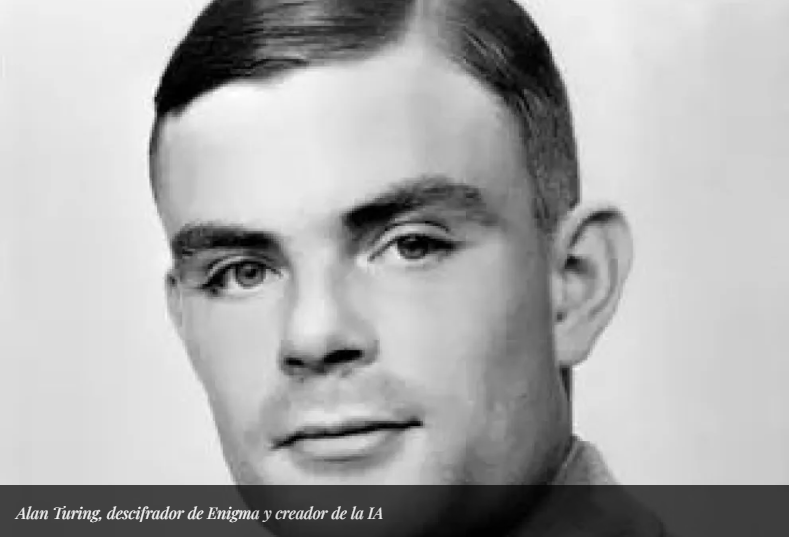The spy and Enigma codebreaker of World War II, who was 70 years ahead of Artificial Intelligence and transformed our present and future.

Some human activities are repeated until they become drives very close to the inevitable. When you learn to drive a car, you discover that reality that, strictly speaking, you already know from a very young age: who should think about the five or six steps that you mechanically perform every morning, when you wake up? It is what St. Thomas, in the thirteenth century, already called “habitus” and recognized as a powerful programmer of spontaneous activities by virtue of the repetitive disposition with which they occurred, which did not make a thought necessary, at least not with reasoning. Thus they had become healthy or pernicious habits that did not involve any reflection.
Biological studies later gave clues as to where all those redundant tasks that came out almost naturally were housed, approaching actions such as breathing or purely involuntary ones such as circulating blood. There is a vast bibliography of all this – although the division into areas of knowledge has determined that ordinary subjects do not consider it a reason for reflection. The investigation of this concept is consciously left to neuroscientists, to experts in cases of specific diseases, to researchers in psychiatry, to psychoanalysts, to laboratories and their developers, to scholastic theologians, etc., etc.
However, sometimes, when someone moves, when they change jobs, when they change their company or lifestyle, the memory bursts in that the habits could have been these, but also different.
We “program” ourselves. And we internalize what works best, and we repeat it. But as soon as one performs new actions, which bring pure reasoning into play, we are urged to new answers. By then, we are already sitting in our jobs, in our renewed learning, in our newly inaugurated emotional interactions. In other words, in the capacities for adaptation and innovation that return in waves from time to time.
The AI revolution seems to be elucidated in light of these behaviors. Because what has been proposed, as a starting point, was to confer on the machines that humanity created by simplifying life in programmed habits, the ability to think according to this second phase of action.
If we observe ourselves in the task of blindly complying with these imperatives, we are being the paradigm of primary machines. Of those that humanity created in the first instance for us. But when machines begin to ask different questions, revolution becomes.
Apparently, the genesis of this subversion dates back many years. The British mathematician and logician Alan Turing wondered if a machine could achieve intelligent behavior that could not be distinguished from that of a human being. In 1950 he published a popular article “Computing Machinery and Intelligence”, published in the journal “Mind”, where he described the “Turing test”.
This survey was established as “a pillar of artificial intelligence and continues to be used as a reference to evaluate the development of intelligent machines,” says Diego Castronuovo, an expert engineer in AI at N5, the renowned software company.
How does the test work? The human moderator interacts with a machine, while also in contact with a person. But he does so without knowing which is which. If the evaluator cannot reliably discern which is the machine and which is the human, the machine is considered to have demonstrated intelligent behavior.
With this, Turing would not only contribute to the development of AI, he would also be a pioneer for the Philosophy of Mind.
What is behind the creator, of not one, but two battering rams that opened portals for the technology we enjoy?
Alan Turing was a British mathematician, computer scientist and cryptanalyst, born in 1912 in London. He died very young, in 1954. Turing showed from childhood an exceptional talent for mathematics and science. He graduated from King’s College, Cambridge University in 1934, having already left his mark on the cloister.
In 1936, he created the “Turing machine”, an abstract model essential for the theory of computation, an innovation as important or more important than that of the test we are referring to.
During World War II, Turing was recruited for cryptanalysis tasks. It was part of a division that deciphered the codes of the “Enigma” machine used by the Nazis, which was central to the Allied triumph and the end of casualties and the war. But he himself also systematized and automated, using the machine popularly known as a “bomb”, the decryption process.
As happened to a British genius such as Oscar Wilde during the nineteenth century, the English twentieth century persecuted Alan Turing for his homosexuality, until he underwent a chemical castration imposed on him by justice. This may have influenced the decline of his health and an early death, at 41 years of age.
However, both his achievements and his crusades remain and multiply as a testimony to the passage through this world of Alan Turing, genius and figure.

